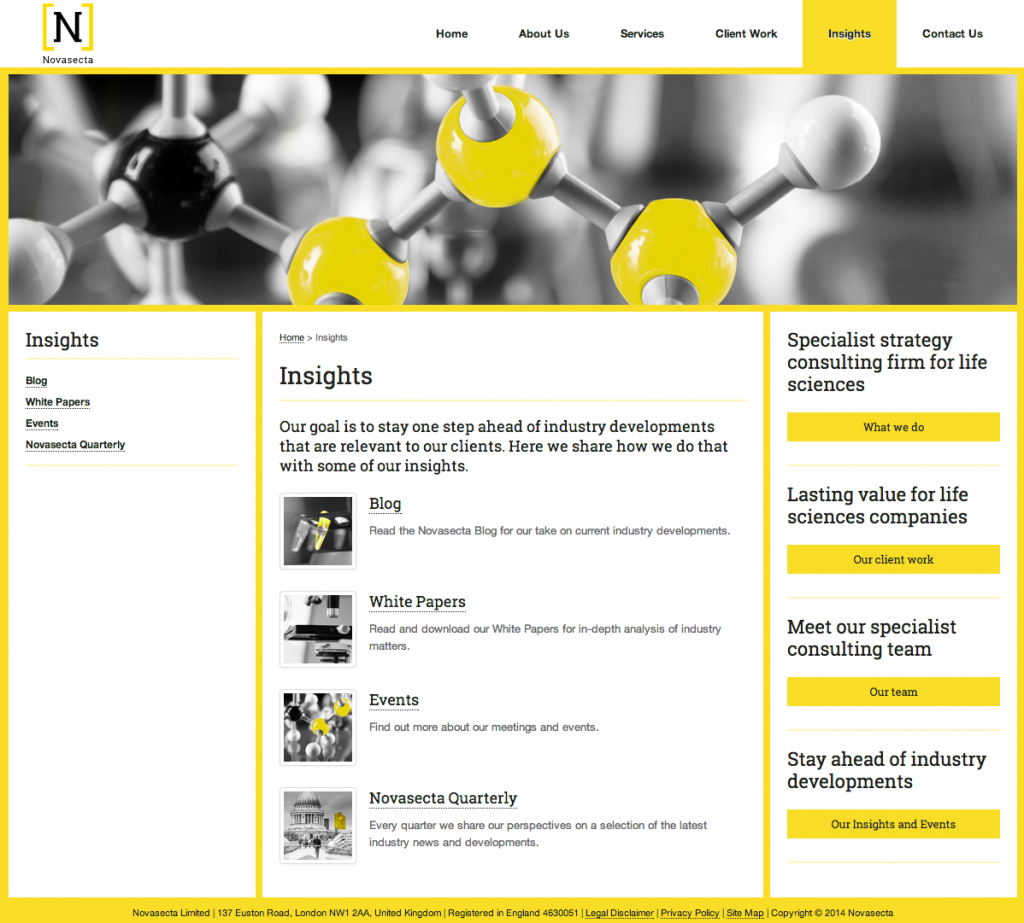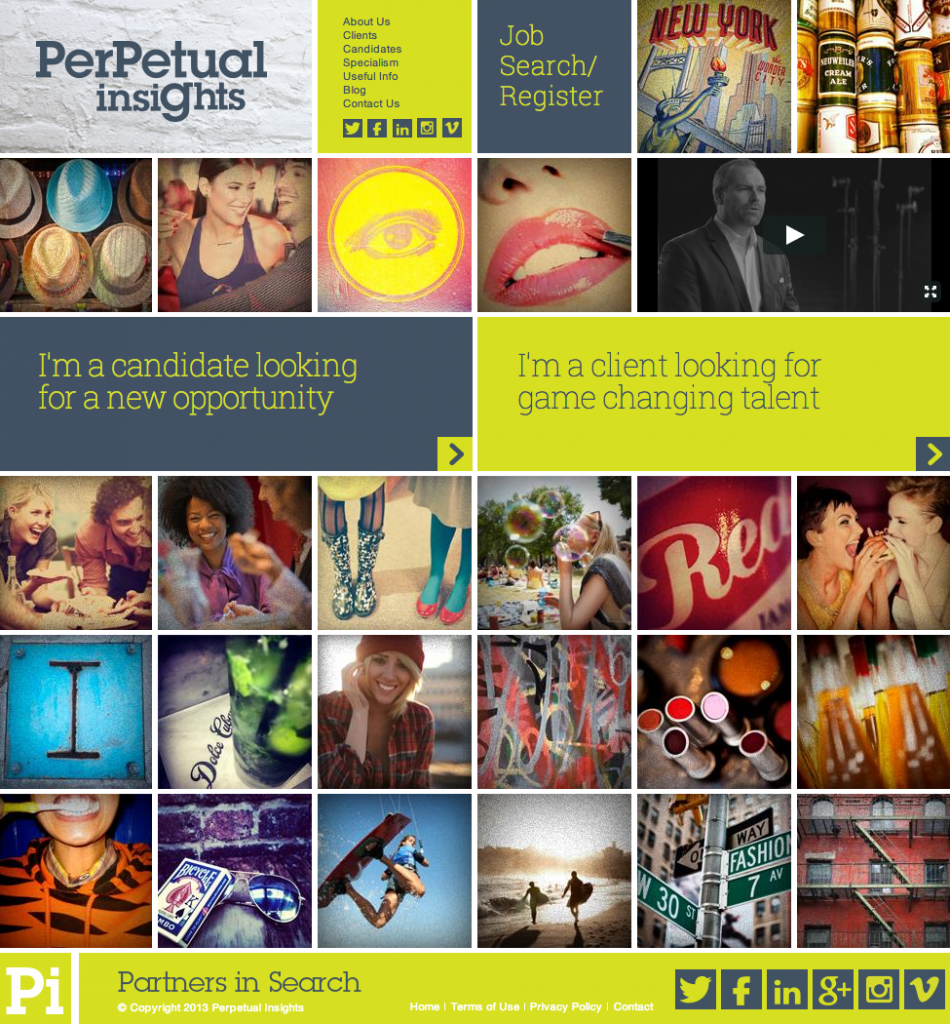What makes a great professional service firm website? Ten considerations …

Photo Credit: appleswitch via Compfight cc
I have yet to write my planned guide on ‘Marketing’ … albeit it will most certainly be one of the next set I do scribe … as prioritised by the reader poll on the site.
The reason for this blog, however, is because the topic of website overhaul has been a ‘hot topic’ for many of the firms I currently advise. Having come from another such meeting recently – with an aspirant consulting firm owner and his newly commissioned web designer – I thought it worth writing a blog on the theme. So herewith, … my top 10 considerations on the path to building a great professional service firm website.
1. Be clear about what your website is there to do
Before I get stuck into this list, it is worth a refresh as to what your website is there to do. There are, of course, many functions your website serves but the primary one, simply put, is to positively-corroborate, in the minds of relevant visitors (e.g. prospective clients, potential recruits, key others) that your firm is well matched to their needs.
You should never rely on your website to sell work – such business development will always be a function of your own efforts (see here); rather, it is a key part of a potential client’s decision-making process … as they step slowly along the psychological journey of first hearing about you towards a determination as to whether to invest their hard-won budgets in your proposed support intervention. The first thing any prospective client will do – after having say met you for the first time (and heard all your self-promoting rhetoric) – is to ‘google’ your company name and take a look at the site. You will want it to reinforce everything you have just claimed – with regards your value proposition, team-based capability, developed intellectual property, evidence of satisfied clients, awards won etc. What you do not want it to project – if you are serious about building a firm with value – is ‘This is just a small operation … and I have just brought in a well-meaning friend to design a logo and build my first site’.
This challenge of positioning your ‘brand’, right from day one, as a premium one (that can command upper-quartile rates) is made up of multiple ‘touch points’ and your website is a really critical component of this. It must get across both the explicit messages (e.g. sectors served, services offered, contact details etc) but also the more ethereal, tacit elements that can be even more important in this client decision-making process (e.g. ‘what do they stand for, would I like to work with this firm?’ type analysis). A great site will, occasionally, generate unsolicited business leads but you should consider this as ‘icing on the cake’; first and foremost, in relation to prospects, it is about brand reinforcement (helping build permission for you to charge high-rates) and client decision-corroboration.
Another key user group (and for early-stage firms, this market can be more critical than the hunt for new clients!) is potential new recruits to your firm. You want to employ the best so, again, remember that any potential candidate is going to form a considerable part of their impression on your company via the website. For some potential candidates, this may be the only interaction they ever have with you. If they see a ‘middle of the road, standard template, corporate blue, dull copy’ site … they will, likely (and probably accurately) infer that you are a a ‘middle-of-the-road, staid’ type of outfit and not seek to take their inspection any further. To win in this market you need to achieve the (difficult) balance of displaying content-depth (as reinforcing of your subject matter expertise) with crisp and memorable design (that says ‘we are a professional and dynamic team to work with and within’).
2. Note the key skills distinction between a designer and a web developer
So, hopefully, I have convinced you that a professional website is really key in your ambition to building a great professional service firm. If you are just starting out, please, please avoid the temptation at this juncture to recruit your friend who does a bit of web design on the side to ‘knock up’ your first site. This really is one of those areas where it is worth investing in professionals from day one. If you are an established business but can see your site does not align with your brand/ambition … time also for an overhaul. Next step, therefore, is to bring in some experts. But, who should you speak to?
A key error professional service firm seniors often make (especially those not from an IT field – engineers, lawyers etc) is the blunt assumption that a single person (or, indeed, firm) can manage all aspects of the remit to overhaul your company brand/logo/design/website. Experience has taught me that the most critical, and hardest to find element, is the designer. Relative to skilled corporate designers, the capability involved in putting together a website is fairly common. Professional service firm websites rarely need complex functionality and, with the proliferation of website templates/themes and development/maintenance tools (e.g. WordPress etc), they are not difficult to build. You should quickly be able to locate many firms proficient in doing so. The mercurial, ‘hard to find’ dimension is the professional designer – and they are rarely in the same agency as the ‘techie’ web guys. Beware those firms that claim to have it ‘all under one roof’ – they really are a very rare exception.
So your first quest is to find a great designer. Of course, you will want to shop around here … and perhaps run a small, competitive ‘beauty parade’ (maybe asking for early stage ideas/designs). Ask respected business owners who they have used and recommend. I personally have spoken to many over the years and the good ones really stand out. Tom, the young designer I now use for the vast majority of my corporate branding work, stood ‘head and shoulders’ above a train of competitors when I first met him. His mode of working was to really understand the context/culture of the business in question, then to generate multiple design options/iterations (with technical flair) and then, in dialogue with me, down-select options that worked, mash ideas together and be really open to this iterative, mutual, creative process. This is the kind of person you are looking for … as opposed to the ‘high-priest’ of design who spends weeks between iterations, gives few options and, with some professional hubris, suggests that their single idea is ‘the one’. Ask around your network to see if anyone knows of a Tom!
3. Be memorable … stand for something
When you meet with your designer, no doubt you will elucidate passionately about how your firm is different from others … with a passion that comes from entrepreneurial zeal and self-belief. When you finish this description you will have – hopefully – a designer bursting with creative energy … ready to hit the drawing board and bring life to your brief. So don’t do what so many do at this juncture … and constrain them to working to a dull set of design guidelines (based on your dull industry/sector norms). Far better to be bold, truly different, memorable. Avoid the safe colours (why is it that most consulting logos and websites are blue?) and dull text-heavy designs. Far better to maybe ruffle a few purists’ feathers but to end up with a site that stands out from the crowd. And to stand out, you have to have to construct a brand that stands for something … as opposed to just wanting to blend into the dull masses.
In the early stages at Moorhouse, we deliberately opted for a bright African violet and green colour palette and used a cartoon figure (the ‘Moorhouse Man’) as a graphical device across much of our website. It served as an irreverent, playful nod towards our value of ‘taking our profession seriously but not ourselves’ and as token counterpoint to the many ‘stuffy’ competitor websites in our sector. Of course, such bold designs can have a ‘Marmite’ impact (a British spread marketed as one that consumers either love or hate) but far better to create this talking point than to be safe, and forgettable, in equal measure. In short, give your designer free rein in the first instance … don’t box them into designing another ‘me too’ brand/website.
4. Be personable … people do business with people
The first thing that a reader will want to ascertain is who you actually are … hear the story of how the firm came to be, what common bond/heritage brought your team together, what you would be like to work with? Ultimately, people do business with people (especially so in the field of professional services).
Many professional service websites don’t even carry a team, or ‘About Us’, page. Even worse, they use a whole load of stock imagery of models-playing-business-folk grinning inanely at the camera. This is a gaping weakness in your marketing effort if so. The best sites (see here as a great example) really bring this aspect to life. Use photos (even better video) and tell the story beyond the professional bios of your team. Put a real, human face to the team, … what really makes them tick, what do they enjoy outside of work?
Communicating this aspect doesn’t dilute your professional demeanour, it just goes someway to saying you are a decent bunch of people that clients (and future new joiners) will enjoy working with. By the way, even if the firm, is just you at the moment … at least shout about the great new MD!

Avoid stock imagery like this …. everyone knows they don’t actually work at your company!
Photo Credit: SalFalko via Compfight cc
As an aside, some larger professional service firms don’t list the entire team (rather a sample set) because either (a) it is too much effort and/or (b) they fear it facilitates competitor efforts to recruit their staff. Don’t succumb to this as it indicates, commensurately, that either (a) you don’t care much for your individual staff and/or (b) you have huge corporate insecurity and, as such, probably aren’t investing enough in building a great firm to work for. Both are portends for firms about to enter decline.
5. Show off your intellectual property … provide value
As I mentioned, your website is a critical communications channel and brand ‘touch point’. You are seeking to build a ‘premium brand’ in order to give you permission to charge ‘premium rates’. Of course, such a position comes from a clear value proposition, your track record and the evidence of how you have proven this value in previous engagements … it also, however, derives from the emotional, more-irrational element of a client’s purchasing decisions. A prospective client will build up a perception of your company; perhaps based on limited, or no actual, interaction with the people within it … but rather through its marketing and the materials, articles it produces. Your website is critical in this regard. You are seeking to build the (justified) perception that you are experts operating at the centre of your chosen industry or field of specialism. The best way to do this is to develop intellectual property (IP) that reinforces this point; for example, a monthly newsletter that summarises key sector activity, thought-leadership papers addressing known client issues, blog posts, survey results, simple tools etc. For a relatively modest (time primarily) investment, you can tacitly reinforce your desired market positioning with such pieces – as long as, of course, they provide genuine value to your readers.
All efforts made in developing intellectual property (and a website that facilitates access to it) will pay off many times over in relation to building long-termvalue into your business … and defending your ability to charge premium rates. Even if you are at an early, capacity-constrained stage set some ambition in this regard (e.g. a quarterly, two-page newsletter) and design this IP library into your website.

A good example of a small/specialised company projecting clear sector expertise through its website/IP
As an aside, you should thinking about using such IP as call-to-action (CTA) ‘hooks’. Professional service firm websites so often miss this out … and give it all away for ‘free’. Far better to capture basic contact information such that you can continue a longer-term dialogue (e.g. regular newsletter, notification of future events etc) with such interested visitors. Even better, is there something you can offer that progresses a potential sales conversation (a free diagnostic tool/review for example)?
6. Third party selling … sells loudest
Of course, the best way to sell what you do is to get others to sell your company for you. Previous client case studies, and testimonials, are gold dust. Your website really needs to bring this aspect to life and make the absolute most of all the great work you have done. If you are just starting out, what about a carousel of positive comments made on your previous work? Regardless, give due care to how this aspect is presented – and kept up to date – on your website. The structure/language should seek to mirror that of the prospective, new client. What was the problem you were asked to resolve (that best matches the language of a typical client)? What was your approach? What did it result in and how did this benefit the client in real, measurable terms? As a real gold standard in this area … you should seek to get video testimonial from your previously delighted clients. Even glowing client testimonial can be a little humdrum nowadays … but seeing and hearing it from a real client is a different story entirely … this really will put you in the top 5% of professional service firm websites!
7. Update content or lose your audience
If there is another cardinal sin in professional service firm websites it is those that are ‘built and forgotten’ … with no material updates other than a six-month old Twitter feed. As per my comments on IP development, even if you are just starting out as a singleton, you really need to set a regular discipline that provides some forward momentum in this regard (e.g. a short, weekly blog post or a quarterly, two-pager insights piece). Before you know it, you will quickly have developed a library of such pieces and, as the team grows, you can add to the ambition … video insights, more detailed ‘white papers’, industry surveys etc.
The point to emphasise here is that your web design and its content management system (CMS) is key. Most modern web platforms (WordPress etc) make this very straightforward but there are still some unscrupulous web agencies out there that seek to get in the way of this process (seeking a fee for on-going page/content updates). Once your site is built, or updated, you are looking for any easy-to-use CMS interface that allows you to update the site’s key content dynamically. The effort should be in producing the future pieces not placing them on your site!
8. Its not all about the traffic … but don’t neglect this aspect
Professional service firm websites are not trading commodity products; as such, high levels of traffic is, often, not a critical concern. Rather, as I have sought to reinforce, it is about premium brand corroboration/reinforcement in the lead-to-contract sales process. That said, you don’t want to make it difficult for potential clients to find you. Unsolicited leads can come about and so you should, of course, maximise these opportunities also. Whilst this blog emphasises the importance of design, there does come a point in this technical build process where it is imperative that your ‘web team’ design in robust ‘Search Engine Optimisation’ (SEO) features … that ensure your site appears highly ranked (first page ideally) when a browser ‘google’ searches for your speciality. Gone are the days when this was a ‘black art’ that could be ‘fixed’ to beat the algorithms. That all said, there are numerous aspects (see the Google design guide) that can be embedded in your site that highlight to the search engines what your pages should be indexed for. At the very least, ensure your web team have a detailed working knowledge of SEO stratagems and arm them with all the key phrases you would expect a browser to use when looking for you.
Thereafter, the key to SEO success (higher search engine ranking, more organic visitors) is relevant CONTENT and links to your site from other sites (that reference and value this content). Regular updated content as per previous point, therefore, serves the double benefit of enhancing traffic as well as your reputation.
Depending on your market and service, you may also wish to pay for such traffic through ‘Search Engine Marketing’ (SEM) by taking out adword (or re-marketing) campaigns with Google, LinkedIn etc. Online sales are rarely the pivotal channel for professional service offerings but, notwithstanding, you should give some deliberate consideration as to how much, if anything, you are willing to spend on search terms that so obviously signal a need for your specific services (if, indeed, SEO doesn’t already get you to the front page of such searches). At the very least, set yourself up a Google Analytics page (it is really very easy – see here) and invest time in tracking the typical usage of your website (numbers, locations, page flow etc) in order to ascertain whether more time/money could be sensibly invested in this area.
9. Copy writing … look outwards not inwards
Another area where professional/technical experts can really get wrong is the language, or ‘copy’, they use on their website. In worst case, it is full of management/technical jargon, self-congratulatory in tone, focused on process as opposed to results and full of ‘we are this, we are that’ type rhetoric. Clients are, conversely, looking for evidence that you really understand their situations/challenges (as framed in their language) and have delivered results in dealing with such matters (they are often not that interested in the process you used to deliver such results). Talk outwards to them as the reader. Good copy that does this well is not easy … so it can pay to invest in the services of a professional copy writer. At the very least, critically re-read all your copy, in the shoes of a typical prospective client (even better get a friendly professional acquaintance, or current client, to do it for you).
10. A key element of great brands …. consistency!
Many business websites have a jarringly, incoherent set of design features including an array of mixed stock photography (different styles/messages). Subconsciously, this tells the viewer of your website that you don’t really have an attention for detail (maybe something that translates to your service delivery?). The key to a great professional service firm website is consistency of message/tone/visual across the entire site.
But remember, having a great professional service website is (final time I will say it) just one element of your marketing tool box. So this brand consistency needs to extend across all your communication mediums and channels … your report templates, your presentation materials, your office decor … right down to your business cards and email signature blocks. If you are taking the trouble to design this from scratch, or to overhaul a tired corporate brand, get your newly appointed designer to develop your brand manifesto … the ‘Bible’ for how you, and all your colleagues, are to use any newly developed assets in their daily operation.
Once the Bible is developed, compliance to it is something you should proudly control – with sharp, pedantic pencil – as a consistent brand projection will quickly become of real value to you.
So, there you have it, a checklist for a critical look at the core component of your company’s external face – your website.
Does it pass the test? Time for a Tom?
——————
If you are interested in re-charging your business ambition/strategy/plans, Dom runs his (three-day) Five-Year Entrepreneur Retreat twice a year (March, September) – see here for previous delegate testimonials and details on future presentations. If you would like to make a reservation (capped to 14 attendees per Retreat) please drop a line via the contact page.



